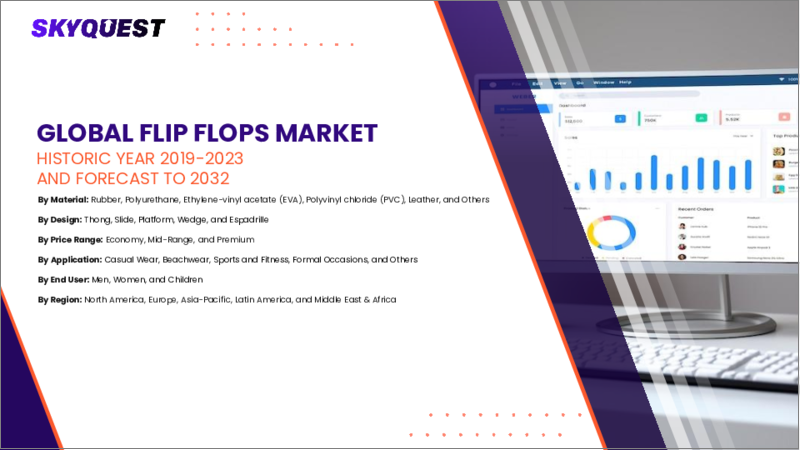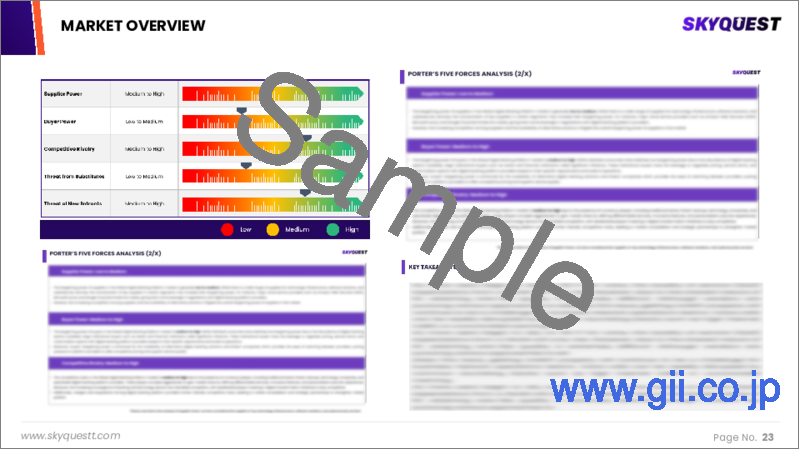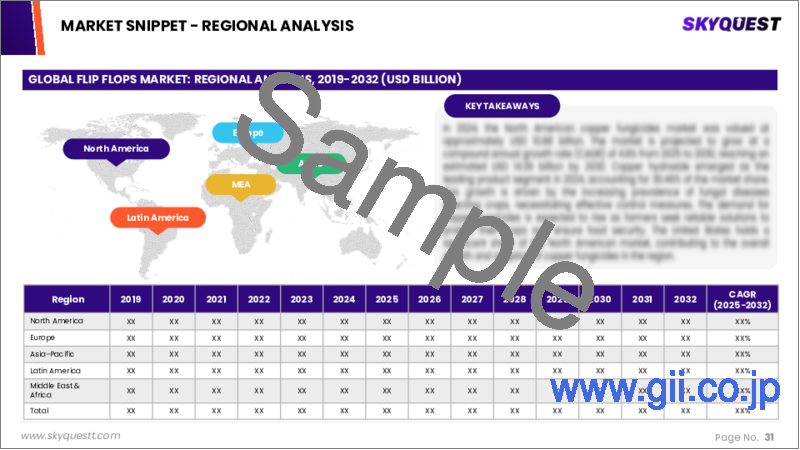|
|
市場調査レポート
商品コード
1646300
ビーチサンダルの市場規模、シェア、成長分析:素材別、デザイン別、価格別、用途別、エンドユーザー別、地域別 - 産業予測 2025~2032年Flip Flops Market Size, Share, Growth Analysis, By Material (Rubber, Polyurethane), By Design (Thong, Slide), By Price, By Application, By End User, By Region - Industry Forecast 2025-2032 |
||||||
|
|||||||
| ビーチサンダルの市場規模、シェア、成長分析:素材別、デザイン別、価格別、用途別、エンドユーザー別、地域別 - 産業予測 2025~2032年 |
|
出版日: 2025年01月27日
発行: SkyQuest
ページ情報: 英文 157 Pages
納期: 3~5営業日
|
全表示
- 概要
- 目次
ビーチサンダルの市場規模は2023年に212億米ドルで、予測期間(2025-2032年)のCAGRは4.5%で、2024年の221億5,000万米ドルから2032年には315億1,000万米ドルに成長する見通しです。
世界のビーチサンダル市場は、その軽量性と消費者の可処分所得の増加に後押しされて成長を遂げています。第二次世界大戦後、米国で日本の草履から広まったビーチサンダルは、カジュアルな履き心地と携帯性の高さが評価されています。しかし、生産に使用される素材に関する環境への懸念が課題となっており、メーカー各社は木材、ヤシの葉、パピルスといった環境に優しい素材など、持続可能な代替品への投資を促しています。持続可能性の圧力に応え、ハヴァイアナスのようなブランドは、熱帯雨林保護を支援するIPEコレクションに代表されるように、収益の一部を環境保護活動に充てています。また、ポリ塩化ビニルやエチレン酢酸ビニルをはじめとする原材料の革新も、エコロジー問題に取り組みながら需要を満たすために生まれており、より責任ある市場へのシフトを示しています。
目次
イントロダクション
- 調査の目的
- 調査範囲
- 定義
調査手法
- 情報調達
- 二次データと一次データの方法
- 市場規模予測
- 市場の前提条件と制限
エグゼクティブサマリー
- 世界市場の見通し
- 供給と需要の動向分析
- セグメント別機会分析
市場力学と見通し
- 市場概要
- 市場規模
- 市場力学
- 促進要因と機会
- 抑制要因と課題
- ポーターの分析
主な市場の考察
- 重要成功要因
- 競合の程度
- 主な投資機会
- 市場エコシステム
- 市場の魅力指数(2024年)
- PESTEL分析
- マクロ経済指標
- バリューチェーン分析
- 価格分析
ビーチサンダル市場規模:素材別& CAGR(2025-2032)
- 市場概要
- ゴム
- ポリウレタン
- エチレン酢酸ビニル(EVA)
- ポリ塩化ビニル(PVC)
- レザー
ビーチサンダル市場規模:デザイン別& CAGR(2025-2032)
- 市場概要
- ひも
- スライド
- プラットフォーム
- ウェッジ
- エスパドリーユ
ビーチサンダル市場規模:価格別& CAGR(2025-2032)
- 市場概要
- エコノミー
- ミッドレンジ
- プレミアム
ビーチサンダル市場規模:用途別& CAGR(2025-2032)
- 市場概要
- カジュアルウェア
- ビーチウェア
- スポーツとフィットネス
- フォーマル
ビーチサンダル市場規模:エンドユーザー別& CAGR(2025-2032)
- 市場概要
- 男性
- 女性
- 子供
ビーチサンダル市場規模:地域別& CAGR(2025-2032)
- 北米
- 米国
- カナダ
- 欧州
- ドイツ
- スペイン
- フランス
- 英国
- イタリア
- その他欧州地域
- アジア太平洋地域
- 中国
- インド
- 日本
- 韓国
- その他アジア太平洋地域
- ラテンアメリカ
- ブラジル
- その他ラテンアメリカ地域
- 中東・アフリカ
- GCC諸国
- 南アフリカ
- その他中東・アフリカ
競合情報
- 上位5社の比較
- 主要企業の市場ポジショニング(2024年)
- 主な市場企業が採用した戦略
- 市場の最近の動向
- 企業の市場シェア分析(2024年)
- 主要企業の企業プロファイル
- 会社概要
- 製品ポートフォリオ分析
- セグメント別シェア分析
- 収益の前年比比較(2022-2024)
主要企業プロファイル
- Havaianas(Brazil)
- Reef(US)
- OluKai(US)
- Teva(US)
- Rainbow Sandals(US)
- Birkenstock(Germany)
- Crocs(US)
- Adidas(Germany)
- Nike(US)
- Under Armour(US)
- Puma(Germany)
- Roxy(US)
- Quiksilver(US)
- Billabong(Australia)
- Rip Curl(Australia)
- Havaianas(Brazil)
- Ipanema(Brazil)
- Rider(Brazil)
- Grendene(Brazil)
- Freedom Moses(Israel)
結論と推奨事項
Flip Flops Market size was valued at USD 21.2 billion in 2023 and is poised to grow from USD 22.15 billion in 2024 to USD 31.51 billion by 2032, growing at a CAGR of 4.5% during the forecast period (2025-2032).
The global flip-flop market is experiencing growth, fueled by their lightweight nature and rising disposable income among consumers. Popularized in the U.S. post-World War II from Japanese zori, flip-flops are celebrated for casual wear and portability. However, environmental concerns regarding the materials used in production pose challenges, prompting manufacturers to invest in sustainable alternatives like eco-friendly materials such as wood, palm leaves, and papyrus. In response to sustainability pressures, brands like Havaianas are committing a portion of their revenue to environmental causes, exemplified by their IPE collection supporting rainforest conservation. Innovations in raw materials, including polyvinyl chloride and ethylene vinyl acetate, are also emerging to meet demand while addressing ecological issues, indicating a shift towards a more responsible market.
Top-down and bottom-up approaches were used to estimate and validate the size of the Flip Flops market and to estimate the size of various other dependent submarkets. The research methodology used to estimate the market size includes the following details: The key players in the market were identified through secondary research, and their market shares in the respective regions were determined through primary and secondary research. This entire procedure includes the study of the annual and financial reports of the top market players and extensive interviews for key insights from industry leaders such as CEOs, VPs, directors, and marketing executives. All percentage shares split, and breakdowns were determined using secondary sources and verified through Primary sources. All possible parameters that affect the markets covered in this research study have been accounted for, viewed in extensive detail, verified through primary research, and analyzed to get the final quantitative and qualitative data.
Flip Flops Market Segments Analysis
Global Flip Flops Market is segmented by Material, Design, Price, Application, End User and region. Based on Material, the market is segmented into Rubber, Polyurethane, Ethylene-vinyl acetate (EVA), Polyvinyl chloride (PVC) and Leather. Based on Design, the market is segmented into Thong, Slide, Platform, Wedge and Espadrille. Based on Price, the market is segmented into Economy, Mid-Range and Premium. Based on Application, the market is segmented into Casual Wear, Beach Wear, Sports and Fitness and Formal Occasions. Based on End User, the market is segmented into Men, Women and Children. Based on region, the market is segmented into North America, Europe, Asia Pacific, Latin America and Middle East & Africa.
Driver of the Flip Flops Market
The flip flops market is experiencing significant growth, driven by an increasing higher-income demographic and millennials' propensity to invest in functional products, alongside a growing awareness of the convenience of flip flops. The digitalization trend and enhanced internet access in key regions have positioned social media as a powerful avenue for marketing trendy flip-flops globally. Additionally, prominent brands are implementing effective marketing strategies and investing in innovative designs and comfort enhancements to boost their competitive edge. Recognizing the environmental impact of traditional materials like PVC and EVA, many companies are embracing innovative technologies and eco-friendly materials to remain relevant in the evolving flip flops market.
Restraints in the Flip Flops Market
The flip flop market faces a significant restraint due to the recommendations for individuals with flat feet to avoid wearing these types of footwear. The lack of proper arch support in flip flops can lead to discomfort and potential foot issues for adults with flat feet, prompting them to seek alternatives that offer better support. Consequently, this restriction in the customer base may hinder the expansion and growth potential of the flip flop market. As health awareness increases, consumers are becoming more cautious about footwear choices, further impacting the demand for flip flops among a segment of the population.
Market Trends of the Flip Flops Market
The flip flop market is experiencing significant growth, driven by a shift in consumer preferences toward comfort-centric footwear during the pandemic, as remote work becomes more prevalent. With approximately 65-70% of the population favoring flip flops for their superior comfort, these casual footwear options are poised to surpass orthopedic footwear in popularity. Additionally, endorsements and fashion statements from celebrities have invigorated interest, positioning flip flops as a trendy choice beyond traditional use. As a result, the flip flop market is projected to witness substantial revenue growth, catering to an increasingly style-conscious yet comfort-driven consumer base.
Table of Contents
Introduction
- Objectives of the Study
- Scope of the Report
- Definitions
Research Methodology
- Information Procurement
- Secondary & Primary Data Methods
- Market Size Estimation
- Market Assumptions & Limitations
Executive Summary
- Global Market Outlook
- Supply & Demand Trend Analysis
- Segmental Opportunity Analysis
Market Dynamics & Outlook
- Market Overview
- Market Size
- Market Dynamics
- Drivers & Opportunities
- Restraints & Challenges
- Porters Analysis
- Competitive rivalry
- Threat of substitute
- Bargaining power of buyers
- Threat of new entrants
- Bargaining power of suppliers
Key Market Insights
- Key Success Factors
- Degree of Competition
- Top Investment Pockets
- Market Ecosystem
- Market Attractiveness Index, 2024
- PESTEL Analysis
- Macro-Economic Indicators
- Value Chain Analysis
- Pricing Analysis
Global Flip Flops Market Size by Material & CAGR (2025-2032)
- Market Overview
- Rubber
- Polyurethane
- Ethylene-vinyl acetate (EVA)
- Polyvinyl chloride (PVC)
- Leather
Global Flip Flops Market Size by Design & CAGR (2025-2032)
- Market Overview
- Thong
- Slide
- Platform
- Wedge
- Espadrille
Global Flip Flops Market Size by Price & CAGR (2025-2032)
- Market Overview
- Economy
- Mid-Range
- Premium
Global Flip Flops Market Size by Application & CAGR (2025-2032)
- Market Overview
- Casual Wear
- Beach Wear
- Sports and Fitness
- Formal Occasions
Global Flip Flops Market Size by End User & CAGR (2025-2032)
- Market Overview
- Men
- Women
- Children
Global Flip Flops Market Size & CAGR (2025-2032)
- North America (Material, Design, Price, Application, End User)
- US
- Canada
- Europe (Material, Design, Price, Application, End User)
- Germany
- Spain
- France
- UK
- Italy
- Rest of Europe
- Asia Pacific (Material, Design, Price, Application, End User)
- China
- India
- Japan
- South Korea
- Rest of Asia-Pacific
- Latin America (Material, Design, Price, Application, End User)
- Brazil
- Rest of Latin America
- Middle East & Africa (Material, Design, Price, Application, End User)
- GCC Countries
- South Africa
- Rest of Middle East & Africa
Competitive Intelligence
- Top 5 Player Comparison
- Market Positioning of Key Players, 2024
- Strategies Adopted by Key Market Players
- Recent Developments in the Market
- Company Market Share Analysis, 2024
- Company Profiles of All Key Players
- Company Details
- Product Portfolio Analysis
- Company's Segmental Share Analysis
- Revenue Y-O-Y Comparison (2022-2024)
Key Company Profiles
- Havaianas (Brazil)
- Company Overview
- Business Segment Overview
- Financial Updates
- Key Developments
- Reef (US)
- Company Overview
- Business Segment Overview
- Financial Updates
- Key Developments
- OluKai (US)
- Company Overview
- Business Segment Overview
- Financial Updates
- Key Developments
- Teva (US)
- Company Overview
- Business Segment Overview
- Financial Updates
- Key Developments
- Rainbow Sandals (US)
- Company Overview
- Business Segment Overview
- Financial Updates
- Key Developments
- Birkenstock (Germany)
- Company Overview
- Business Segment Overview
- Financial Updates
- Key Developments
- Crocs (US)
- Company Overview
- Business Segment Overview
- Financial Updates
- Key Developments
- Adidas (Germany)
- Company Overview
- Business Segment Overview
- Financial Updates
- Key Developments
- Nike (US)
- Company Overview
- Business Segment Overview
- Financial Updates
- Key Developments
- Under Armour (US)
- Company Overview
- Business Segment Overview
- Financial Updates
- Key Developments
- Puma (Germany)
- Company Overview
- Business Segment Overview
- Financial Updates
- Key Developments
- Roxy (US)
- Company Overview
- Business Segment Overview
- Financial Updates
- Key Developments
- Quiksilver (US)
- Company Overview
- Business Segment Overview
- Financial Updates
- Key Developments
- Billabong (Australia)
- Company Overview
- Business Segment Overview
- Financial Updates
- Key Developments
- Rip Curl (Australia)
- Company Overview
- Business Segment Overview
- Financial Updates
- Key Developments
- Havaianas (Brazil)
- Company Overview
- Business Segment Overview
- Financial Updates
- Key Developments
- Ipanema (Brazil)
- Company Overview
- Business Segment Overview
- Financial Updates
- Key Developments
- Rider (Brazil)
- Company Overview
- Business Segment Overview
- Financial Updates
- Key Developments
- Grendene (Brazil)
- Company Overview
- Business Segment Overview
- Financial Updates
- Key Developments
- Freedom Moses (Israel)
- Company Overview
- Business Segment Overview
- Financial Updates
- Key Developments






